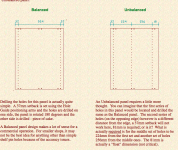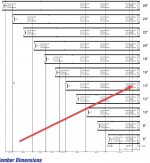Hi,
I am planing my first cabinets with 32mm holes and have a couple of questions. I am interested both in the "correct" way to do things and how people sole the problem for themselves particularly with something like the woodpecker jig (which is what I have).
1. I know this doesn’t matter for shelf pins, hinges and drawers but what is the distance of the first hole from the bottom? The woodpecker jig has a 37mm offset but I saw both 37 and 42mm. I assume that is from the interior corner of the cabinet and not from the bottom of the side panel? But that would mean the placement of holes from the bottom has to consider the thickness of the stock so that the distance from the bottom is stock thickness plus 37mm. The woodpecker jig is not really designed for that with the pins for placement. Does this matter for anything?
2. How do you deal with drawer slides? The front hole is easy with 37mm setback from the finished edge. However, the backhole is more complicated. If I place them 37mm from the back (which the woodpecker jig is designed to do), the mounting hole in the back doesn't necessarily fit. Would the correct approach be to place the back holes at X times 32mm instead of 37mm from the back? I think slides have mounting holes every 32mm. With something like the woodpecker jig, do people simply drill the back hole manually or is there a different approach?
3. I sometimes see an additional column of holes in the middle of the side panel. What is the purpose of these holes?
I am planing my first cabinets with 32mm holes and have a couple of questions. I am interested both in the "correct" way to do things and how people sole the problem for themselves particularly with something like the woodpecker jig (which is what I have).
1. I know this doesn’t matter for shelf pins, hinges and drawers but what is the distance of the first hole from the bottom? The woodpecker jig has a 37mm offset but I saw both 37 and 42mm. I assume that is from the interior corner of the cabinet and not from the bottom of the side panel? But that would mean the placement of holes from the bottom has to consider the thickness of the stock so that the distance from the bottom is stock thickness plus 37mm. The woodpecker jig is not really designed for that with the pins for placement. Does this matter for anything?
2. How do you deal with drawer slides? The front hole is easy with 37mm setback from the finished edge. However, the backhole is more complicated. If I place them 37mm from the back (which the woodpecker jig is designed to do), the mounting hole in the back doesn't necessarily fit. Would the correct approach be to place the back holes at X times 32mm instead of 37mm from the back? I think slides have mounting holes every 32mm. With something like the woodpecker jig, do people simply drill the back hole manually or is there a different approach?
3. I sometimes see an additional column of holes in the middle of the side panel. What is the purpose of these holes?


